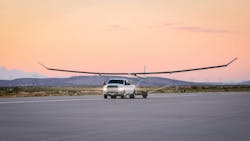Swift Engineering awarded NASA SBIR Phase II contract to advance high-altitude drone development
Summary points:
-
Swift Engineering received a $1.2 million Phase II SBIR award from NASA to continue development of its Swift Ultra Long Endurance (SULE) high-altitude drone, designed for 30-day missions in the stratosphere.
-
The solar-electric SULE platform recently reached 55,904 feet during a 24-hour test flight and features a 72-foot wingspan, 15-pound payload capacity, and modular construction for rapid deployment.
-
Swift's work aligns with NASA’s interest in high-altitude platforms for Earth observation and climate monitoring, and supports broader efforts to lower costs and increase readiness for persistent aerial missions.
SAN CLEMENTE, Calif. - Swift Engineering has received a Phase II award under the National Aeronautics and Space Administration's (NASA) Small Business Innovation Research (SBIR) program to support continued development of its Swift Ultra Long Endurance (SULE) high-altitude platform system (HAPS), the company announced.
The award provides funding for further design, fabrication, and flight testing of the SULE uncrewed aircraft system (UAS), which is being developed to fly for up to 30 days at a time. The long-endurance platform is designed to reduce the cost of persistent data collection while increasing availability for both defense and commercial applications.
"The resources and support of the NASA SBIR program are vital to driving technology innovations that are critical in addressing multiple challenges and opportunities," said Hamed Khalkhali, president of Swift Engineering. "We are proud to have been involved in this program on multiple occasions in pursuit of delivering high-performance, cost-effective solutions."
Swift announces its SULE uncrewed aircraft flies above 55,000 feet
Observation from altitude
NASA considers high-altitude platforms - including balloons and drones - to be useful for Earth observation, climate monitoring, and emergency management due to their ability to collect consistent data from the stratosphere. The SBIR program supports these efforts by funding the development of novel instruments and flight demonstrations.
Swift Engineering's SULE vehicle reached an altitude of 55,904 feet during a 24-hour flight late last year, a key milestone in the platform's development. The company previously received a Phase I SBIR contract for the SULE system and has earned several other SBIR awards for technologies including long-endurance and expendable drones, water monitoring systems, and scientific payload platforms.
UAVOS joins HAPS alliance to drive development in high-altitude UAS
Swift’s SULE UAS is engineered for solar-electric operation: it climbs to stratospheric altitudes using battery power and sustains flight via solar energy, with plans to achieve more than 30 days airborne at around 60,000 feet.
Designed as an attritable platform, emphasizing lower-cost, partially expendable, and easy-to-transport components, SULE fits within a standard 40-foot shipping container and may be deployed with a two- to three-person crew.
About the Author
Jamie Whitney
Senior Editor
Jamie Whitney joined the staff of Military & Aerospace Electronics in 2018 and oversees editorial content and produces news and features for Military & Aerospace Electronics, attends industry events, produces Webcasts, and oversees print production of Military & Aerospace Electronics.
